Why Do Birds Need a Heated Bird Bath?
What’s the best thing I can do for birds in winter? asks Liza Peniston of Augusta, Kansas.

With colder weather arriving in much of the country soon, it’s time to start thinking about how to make your backyard a haven for winter birds. Kenn and Kimberly Kaufman advise, “Unless there’s persistent and heavy snow cover, birds are quite adept at finding natural sources of food. But finding open water is more of a challenge. We recommend maintaining a source of clean, fresh water. In our backyard, we use a simple bird bath heater to keep water available all winter long. We’ve seen birds drinking and even bathing—which shouldn’t cause alarm—when the temperatures are below freezing. Clear snow off the edges of your heated birdbath so winter visitors, like northern cardinals, can access the water.”
Many birds that rarely visit feeders will stop by a heated bird bath for a drink. Here are our top heated bird bath picks, so birds have fresh water even in freezing weather.
The Best Heated Bird Baths
Detachable Heated Bird Bath

Heated bird baths like this style are pretty reasonably priced, and you can plug them right into an outdoor outlet on your patio or back porch. They heat water just enough to keep it from freezing, without making it too warm. (Birds don’t want to drink hot water.)
Check out the best bird baths and fountains for attracting birds.
Heated Bird Bath with Stand

This bird bath is elevated on a metal stand, so it’s a great choice if you don’t have a deck railing or balcony. It’s also easy to move closer to your front door, so you won’t have to trudge through the snow drifts to fill it.
Learn the best ways how to clean a bird bath.
Little Giant Heated Pedestal Bird Bath

This classic, pedestal style heated bird bath looks sturdy enough so that it won’t blow over, even in a blizzard.
Bird Bath De-Icer
If you already have a bird bath in your yard that you love, add a de-icer for the winter months. Just plug it in and place it in the water. As a bonus, it gives birds a raised surface to perch on while they take a drink.
More Winter Bird Bath Tips

Keep the Water Moving
If the temperatures aren’t too cold, just keeping the water moving can be enough to keep it from freezing. Try adding a Water Wiggler or small fountain to your birdbath. These are nice in warm weather too, when the moving water keeps mosquitoes away.
Choose a Winter Bird Bath Wisely
Avoid concrete, stone, or glass bird baths in the winter, as they can crack if the water freezes. Shallow bowls are best, since birds may only use the bath for drinking when the weather is cold.
“I set a shallow dish filled with water on a barrel located just below a window. Because the water freezes quickly, I just open the window, remove the ice that accumulates in the dish and refill it. It’s very convenient, and the birds appreciate my extra effort,” says Margaret Retz of Boyceville, Wisconsin.
Is it safe to freeze hummingbird nectar?
Fill Bird Baths Frequently in Winter
If a heated bird bath is out of your price range, try moving your bird bath close to a window and filling it with warm (not hot) water several times each day. It’s a short-term solution, but it also encourages you to keep on eye on your birds and makes you a better bird-watcher! Psst—Never add any kind of additives to your water to keep it from freezing. They are simply not safe for birds.
“I don’t have a heated bird bath, but I still provide water for my winter birds during the cold season. In the morning when the water in my bird bath is frozen, I simply pour hot water over the ice. This quickly loosens it, and I pop the ice right out of the bird bath. Then I refill it with warm water. When it’s really cold, I’ll do this a few times a day,” says Sherry Schoberg of Elkridge, Maryland.
Next, learn how hummingbirds survive snow and cold weather.
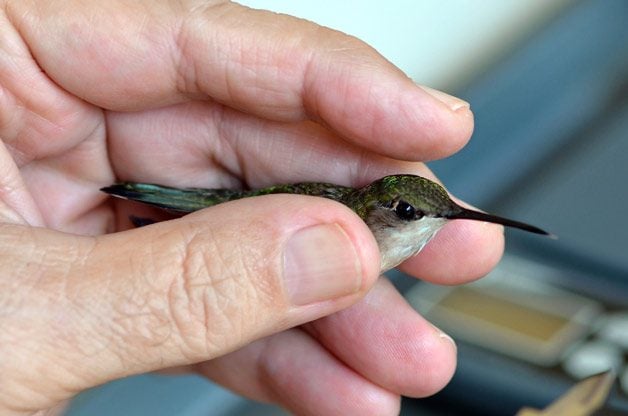
You always hear about the banding of songbirds and raptors, but rarely about banding and tracking hummingbirds. Turns out that hummingbird banding is an extremely specialized activity. Read on to discover how it works, what makes it unique and a little about the people behind the research and tracking of these tiny treasures.
The Number of Banded Hummingbirds is Low
Hummingbird banding started long after songbird banding, so researchers don’t have nearly as much information on the tiny fliers as they do on other birds. According to the North American Bird Banding Program operated by the U.S. Geological Survey and the Canadian Wildlife Service, about 309,000 ruby-throated hummingbirds have been banded and tracked since 1960. By comparison, more than 30 million songbirds have been banded.
Check out proven hummingbird photography tips.
Hummingbird Tracking is a Useful Migration Research Tool
Most of what we do know about hummingbird migration is because of hummingbird tracking and banding. The data scientists have gathered thus far tell us amazing things. For instance, we know that ruby-throated hummingbirds follow the same migration routes every year. They also arrive at and leave from stopover points on almost the same date each year, within a few days.
Discover the top 15 colorful flowers hummingbirds like.
The Banding Process Does Not Harm Hummingbirds
Hummingbird feeders equipped with curtains, netting or cages are monitored, and when a bird visits, it flips a switch and the netting comes down or the cage closes. This is a more effective method for capturing hummingbirds than the large mist nets usually used in songbird banding.
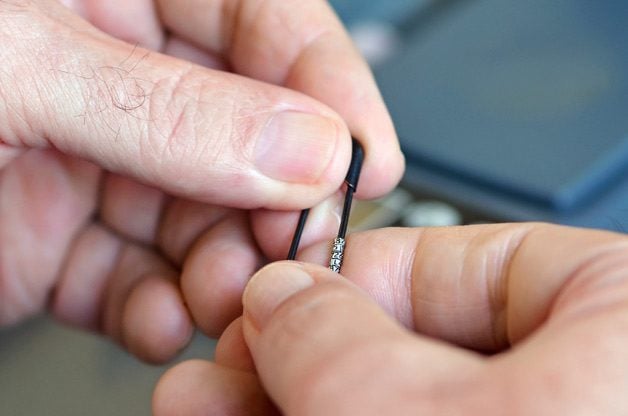
Hummingbird Bands Are Incredibly Tiny
As you might expect, the bands that go around the leg of a hummingbird are minuscule—so small they fit around a toothpick or safety pin. Typically, they measure just 1.27-1.52 mm in diameter and 1.6 mm wide. Each band bears a letter prefix followed by a four-digit number. The letter represents a five-digit number that is too big to print on the tiny band.
Check out 17 jaw-dropping facts about hummingbirds.
You Can Help Report and Track Rare Hummingbirds
If you think you have a rare hummingbird visiting your backyard or a hummer that seems to be staying for the winter, banders may be interested in your guest. Increasingly, Western hummingbirds are showing up in the East, and you can help researchers find out why by alerting banders.
Learn the 15 types of hummingbirds found in the United States.
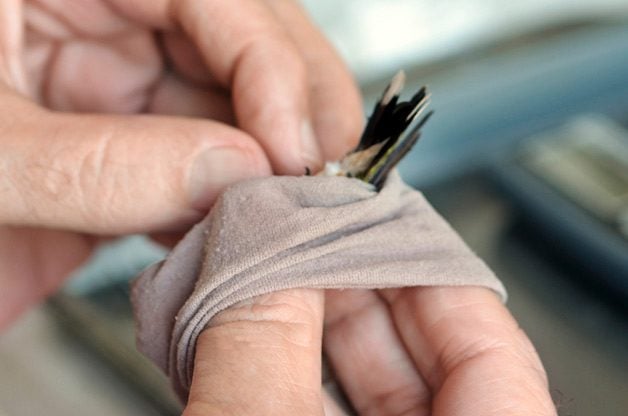
Hummingbird Banders Are a Specialized Group
Only about 150 people in the U.S. hold permits to band hummingbirds. They’re authorized to take part in the program after completing rigorous training. Unlike other bird bands, those made for hummingbirds are cut and sized by the banders themselves. Banders are also expected to follow a code of ethics.
Check out the ultimate bucket list for hummingbird lovers.
Hummingbird Banding is Quick
Hummingbirds aren’t in the banders’ hands for long. Banders work swiftly to record species, sex, age, weight, measurements and the birds’ overall condition. After that, banders sometimes offer the birds a quick drink at a sugar-water feeder before promptly releasing them.
Meet the world’s largest and smallest hummingbirds.
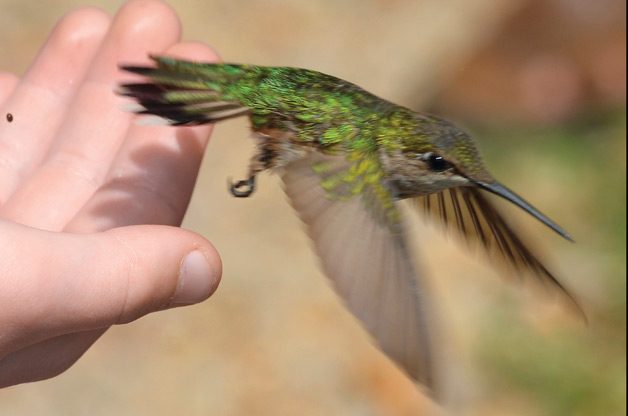
Timing and Location Are Important for Hummingbird Tracking
It makes sense to kick up hummingbird banding efforts during migration. Banders gather at crucial flyway areas. Alabama’s Fort Morgan Banding Station, for instance, is the first landfall and the last departure location along the Gulf of Mexico for thousands of migratory birds, including ruby-throats. Banding in southeast Arizona is especially important, because this part of the international flyway hosts the greatest diversity of hummingbird species anywhere north of Mexico. Arizona researchers are able to examine and track tropical species heading north as well as common migrants like the rufous and calliope hummingbirds.
Psst—you need to see these stunning hummingbird photos.
Hummingbird Banders Are Banders for Life
Take Bob and Martha Sargent, who founded the nonprofit Hummer/Bird Study Group for songbird and hummingbird tracking. Since they started their original banding station in their Clay, Alabama, backyard, more than 30,000 ruby-throats have been banded there. Other devoted banders spend years researching and tracking hummingbirds, running websites to spread awareness and doing banding demonstrations. So it’s true: Once a hummingbird bander, always a hummingbird bander.
Learn how to attract hummingbirds with 10 expert tips.
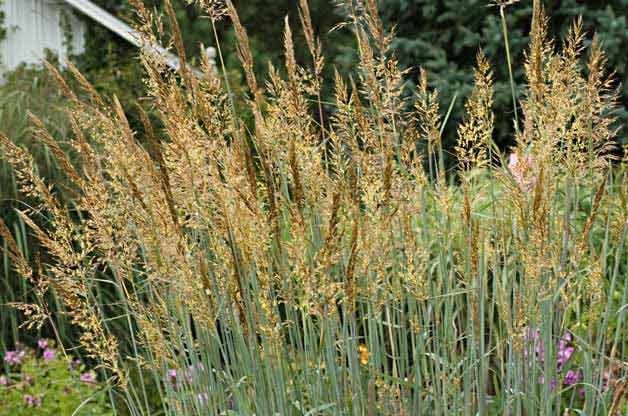
Ornamental Grass: Indian Grass
Sorghastrum nutans • Zones 5 to 8
Indian grass will add stunning greens, glowing bronzes and cool blues to your garden throughout the year with little work on your part. This ornamental grass grows up to 4 feet high and 2 feet wide, giving it a spectacular columnar effect.
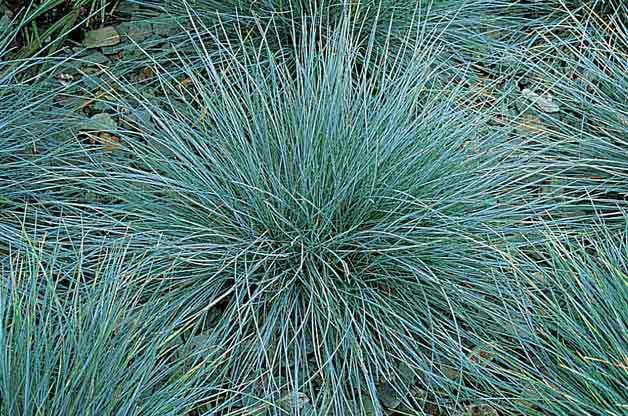
Blue Fescue
Festuca glauca • Zones 4 to 8
Lovers of these ornamental grasses don’t mind having the blues at all. You’ll warm up to blue fescue, too, for its compact, container-friendly tufts and bright hue. It grows to about 6 to 12 inches tall.
We found beautiful blue flowers for every garden.
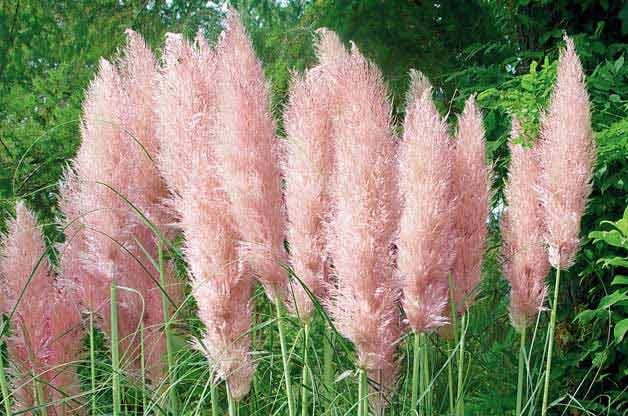
Pampas Grass
Cortaderia selloana • Zones 6 to 11
Add some drama to your yard with these fast-growing, eye-catching plumes. Feathery pampas grass grows up to 10 feet high and 5 feet wide, but some of the more compact cultivars, including Pumila and Compacta, produce plants that are about 6 feet tall. Pampas grass is invasive in some parts of the United States and should not be planted in California or Hawaii.
Pretty in pink: Try these 10 shrubs with pink flowers.
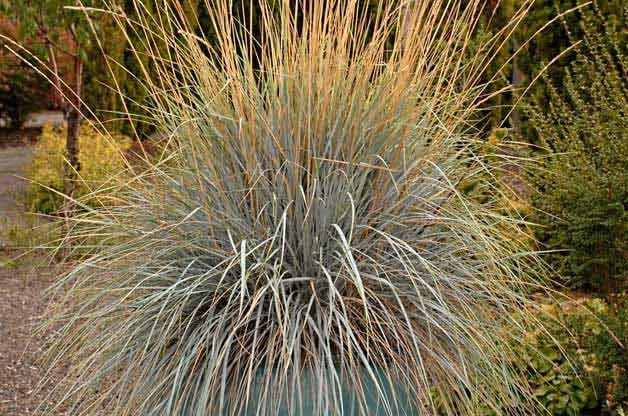
Blue Oat Grass
Helictotrichon sempervirens • Zones 4 to 8
Planted in a border or container, or used as a stand-alone accent, gardening with ornamental grasses like the blue oat grass makes a big statement in any backyard. This ornamental attains greater height and stronger blades than blue fescue while showing off a similarly striking shade of blue. For best foliage color, give it full sun in cool regions and light shade in warm areas.
Discover more easy plants you can grow in containers.
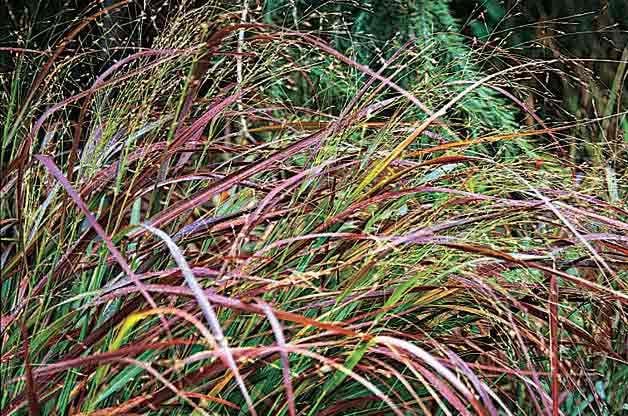
Switchgrass
Panicum virgatum • Zones 4 to 9
This easygoing and versatile ornamental grass is a good choice for wet conditions, drought or partial shade, as long as it’s planted in moist, well-draining soil. Growing narrow and upright with a cloud of seed heads in fall, switchgrass can reach more than 5 feet tall. This grass is native to North America. However, it reseeds readily, so buy from a regional source.
Check out the top 10 easy-to-grow native plants.
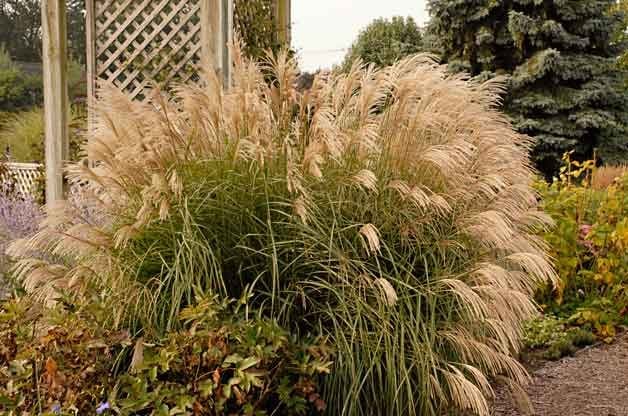
Miscanthus
Miscanthus sinensis • Zones 4 to 9
You’ll be on cloud nine with the fluffy tops of this ornamental grass. The big, showy flower heads and height of up to 12 feet give it a graceful profile. In autumn, its silky gray panicles turn maroon or purplish-brown. Plant miscanthus in a sun-drenched area. Be sure to only grow sterile cultivars, as it can be invasive.
Check out the best fall shrubs to grow.
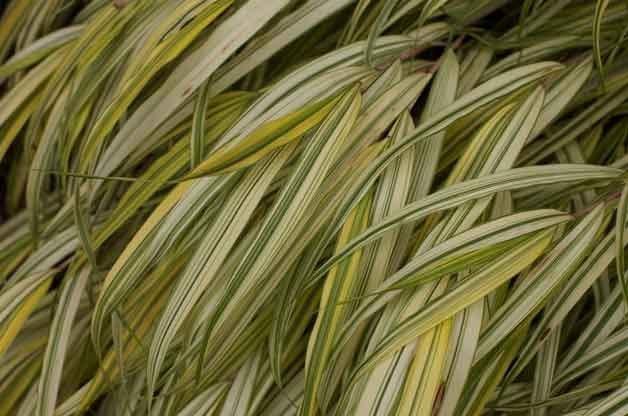
Japanese Forest Grass
Hakonechloa macra • Zones 5 to 9
This slow-growing plant has dense masses of arching golden stems that take on a reddish-pink tinge in fall. To enliven a shady area, plant it as a specimen, ground cover or border.
Psst—don’t miss the top 10 golden plants to make your garden glow.

Elliott’s Lovegrass
Eragrostis elliottii • Zones 6 to 10
Native to the Southeast, this ornamental grass has interesting colors when viewed up close, and is incredibly easy to grow. In the late summer and fall, the seed heads (inflorescences) appear, adding an airy feeling and providing food for small birds. If you live too far north to grow Elliott’s lovegrass, you can grow purple lovegrass (Eragrostis spectabilis) instead. Look for both at native plant nurseries in your area.

Muhly Grass
Muhlenbergia capillaris syn. M. filipes • Zones 7 to 10
A foolproof southeastern native, muhly grass is green and full most of the year, growing to about 3 feet by 3 feet. In October the plumes rise above the body of the grass, putting on a show that’s unequaled among ornamental grasses. By late in the year, the feathery purple fronds fade to a soft light brow. Planted in groupings, it creates shelter for small creatures including butterflies. Songbirds love the seeds produced in the fall, and may even pluck dead stems to use in building their nests.

Grow Native Grasses for Wildlife
Native ornamental grasses are full of life. They sway in the wind, bow beneath snow and rustle with a music all their own throughout the seasons.
Keep an eye on those graceful clumps, and you’ll see life of another kind, too. Birds and butterflies love them. Native sparrows, finches and other small birds forage for seeds from grasses in the garden, just as they do in the wild. And more than 100 butterfly species, especially skippers, use certain grasses as host plants.
With so many kinds of ornamental grasses on the market, and new ones joining them every year, how’s a gardener to know which ones are best for birds and butterflies? It’s simple, really. Grow native grasses!
Check out 9 gorgeous ornamental grasses for your yard.
Native Grasses to Attract Birds
Birds visit all North American native grasses, thanks to the bounty of nutritious morsels on the plumes, spikes or sprays. For juncos, native sparrows, buntings and other seed-eating birds, it doesn’t matter what part of the country the grass is originally from. Many natives, such as switchgrass, big bluestem and Indian grass, are already garden favorites as ornamentals, both in their original form and in variations like the Heavy Metal cultivar, which is a cool blue-gray.
Don’t expect to see your ornamental grasses bowing under a flock of feeding goldfinches, though. Instead, look for finches, native sparrows, juncos, doves and other birds on the ground beneath the plants in fall and winter, stretching for overhanging seed heads or scratching for fallen seeds.
Don’t miss the top 10 easy-to-grow native plants.

Ornamental Grasses for Nesting Birds and Butterflies
In spring, when nesting season arrives, any and all grasses may be the focus of birds’ attention. Dead grass, that is. Dry grass is lightweight, plentiful, easy to maneuver around and a cinch to collect. Birds aren’t fussy about what they use in their nests, as long as it’s strong and flexible.
Robins, song sparrows, wrens and other birds use coarse grass blades, such as miscanthus, for the main wall of the nest. The dead leaves of other fine-textured grasses often serve as part of the soft inner circlet that lines the nest.
Native grasses come into their glory as summer arrives, and that’s when delightful grass skipper butterflies take an interest in them, too. This big subfamily includes about 140 species, all with a definite predilection for grasses as host plants.
So go ahead and grow grasses to your backyard. Fall is still a good time to plant them. You’ll be well on your way to attracting even more birds and butterflies to your space.
Check out 17 blooming bushes that attract butterflies.
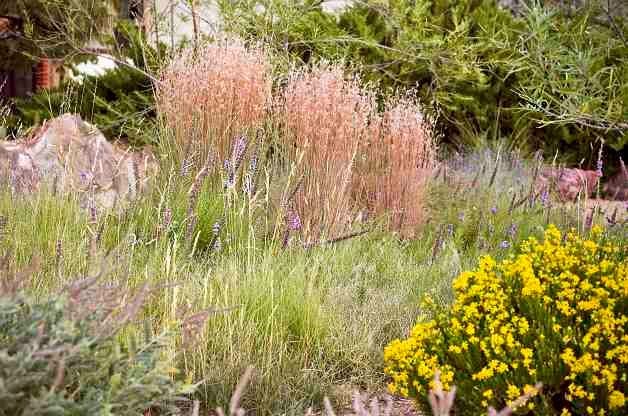
9 Native Ornamental Grasses
- Big bluestem (Andropogon gerardii)
- Blue grama grass (Bouteloua gracilis)
- Indian rice grass (Achnatherum hymenoides)
- Little bluestem (Schizachyrium scoparium)
- Muhly grass (Muhlenbergia spp.)
- Northern sea oats (Chasmanthium latifolium)
- Prairie dropseed (Sporobolus heterolepsis)
- Sideoats grama (Bouteloua curtipendula)
- Switchgrass (Panicum virgatum)
Next, check out the top 10 perennial ornamental grasses to add to your garden.
When it comes to the smartest bird, we humans still have a lot to learn. Bird intelligence comes in many forms, and scientists are finding that many species exhibit intelligence similar to that of marine mammals, apes and even humans. Parrots come to mind, with their ability to solve problems, form emotional bonds, mimic speech and even understand some rudimentary grammar. But smarts aren’t the sole domain of tropical birds. Corvids—including crows, ravens, jays and magpies—are renowned for their intelligence, too. Many other backyard birds are no slouches. Take a look at the smartest bird species that get bragging rights for their brainy behavior.

Smartest Birds: Planning and Memorizing
Some birds, especially woodpeckers and jays, hoard nuts for later feeding. The collecting and caching of food an example of planning for the future. The birds’ ability to find their hidden treasure later on demonstrates impressive long-term memory. Similarly, fruit eaters such as robins and cedar waxwings remember where specific trees are and when they will fruit. Hummingbirds recall which individual plants in their habitat are rich with nectar and will return each year to those very flowers, trees or bushes.
Discover 17 jaw-dropping facts about hummingbirds.

Smartest Birds: Working Together
Smart birds work cooperatively and understand the concepts of mutual benefit and the greater good. Harris’s hawks of the Southwest hunt in family packs similar to those of wolves or lions, working together to flush and ambush prey. Wild turkeys line up wing to wing and walk across fields. They know they can flush more insects in that formation than if they scattered or walked single file. Crows live in highly structured family groups comprising several generations. They readily team up to mob predators, knowing there is strength in numbers.
The smartest bird species are even wise enough to transcend species barriers. Chickadees and nuthatches, for example, have been observed responding to each other’s predator warning calls, in a kind of predator-alert symbiosis.
Check out 15 common backyard birds you should know.
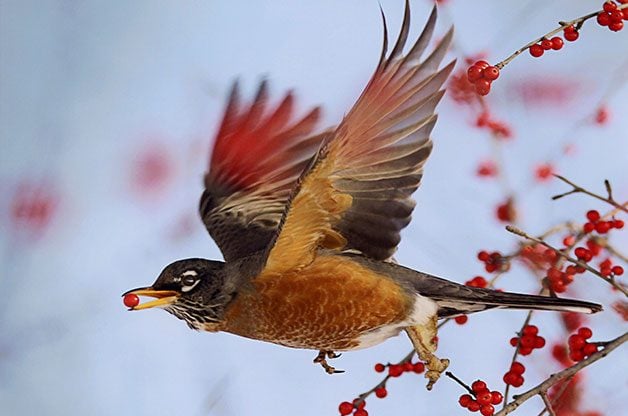
Smartest Birds: Recognizing Faces
Many birds bravely defend their nests, attacking potential predators to drive them away, but this defensive behavior is typically indiscriminate. Any perceived threat is mobbed or dive-bombed. Yet a recent study of northern mockingbirds documented that they not only recognize individuals of a potentially dangerous species but remember an individual’s past behavior and single him or her out for attack. Researchers determined this by asking a series of people to approach a mockingbird nest. One particular person approached the nest several times. The birds learned to recognize this individual and could actually pick him out of a crowd. They marked him as a threat and pre-emptively attacked him, while ignoring others who randomly walked by the nest.
This behavior has been reported anecdotally in other species as well, including robins. Further research could well reveal that still other kinds of birds have this ability to recognize not just a threatening species but a particular human or other potential predator—undeniably a sign of sophisticated intelligence.
Does your birth month bird match your personality?
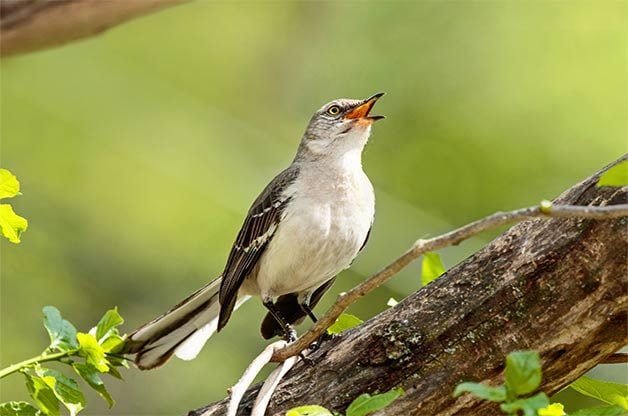
Smartest Birds: Mimics
Speaking of mockingbirds, they’re astonishing in their ability to learn and mimic foreign noises. They get their name, of course, from the ease with which they can deliver the songs of shrikes, blackbirds, orioles, killdeer, jays, hawks and even frogs. Other smart birds are almost as versatile. Steller’s jays mimic many wild birds, as well as chickens, squirrels, cats and dogs. Blue jays expertly imitate red-shouldered hawks. European starlings (which, despite their name, are widespread in North America) learn and repeat the songs of eastern wood pewee, killdeer, meadowlarks and many others. They even mimic cellphone ring tones and other urban noises. In captivity, the exceptionally intelligent raven has been taught to mimic human words. Move over, Polly!
Learn more about bird mimics and mimicry.
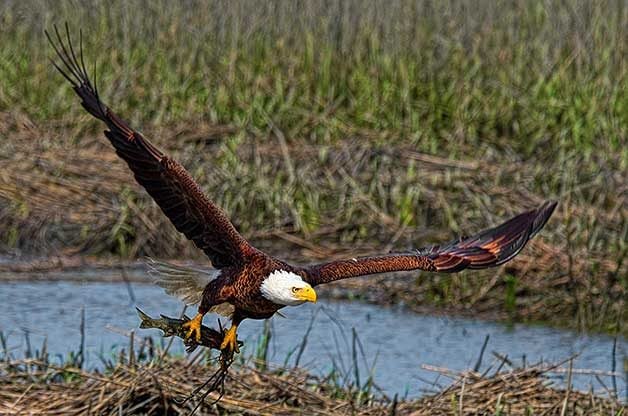
Smartest Birds: Solving Problems
Some smart birds are savvy enough to use trial and error to adapt to new situations. Bald eagles have been seen swimming across the surface of the water, dragging prey behind them, after attempts at holding on to the prize while in flight proved ineffectual. They’ll also crack ice with their strong beaks. Then they jump up and down on it, breaking through to expose open water for fishing.
And we know that the smartest bird species understand cause and effect. Gulls drop mollusks and crustaceans from high in the air, letting them crash on the rocks to crack their hard shells. Ravens often follow the sounds of hunters’ gunshots. They have learned that such noises mean the possibility of scavenging the remains of the game after field dressing.
What types of birds mate for life?

Smartest Birds: Using Tools
Tool use was once believed to be exclusive to humans—one of the things that set us apart from all other species. But study after study has shown that many other species use tools to survive. We take for granted that nest-building birds use twigs, plant fibers, hair, spiderwebs, lichen, mud and even plastic to build nests – definite tool use. Other even more astounding examples have come to light, though, showing how much smarter birds are than previously thought.
Predatory shrikes, lacking the strong talons of raptors to grip their prey while feeding, use thorns or even barbed wire to impale their victims for easier eating. Gila woodpeckers use bits of bark for scooping up honey to bring back to their young. Green herons have been observed fishing with bits of bread that people have tossed out for ducks. They use the bait to lure small fish to the surface, where they are easily caught. And one of the oldest and most whimsical stories of a bird using a tool is the Aesop fable “The Crow and the Pitcher.” In the tale, the crow drops pebbles into a pitcher of water, raising the level of the liquid so it can take a drink. Animal behaviorists have confirmed that this trick wouldn’t be beyond the capacity of an intelligent crow.
Next, check out the top 10 cutest birds in America.
Everyone loves seeing all the beautiful warblers in their breeding colors during spring migration but, seeing fall warblers can be just as much fun. The only trouble can be that some of the birds will cause more of an identification challenge during this time of year. One of the most common challenges is deciding if you’ve seen a blackpoll warbler or a bay breasted warbler. Although you would never mistake these two species in the spring, it can be quite easy to do in the fall.
Here are a few tips to help you with your fall warbler identification.
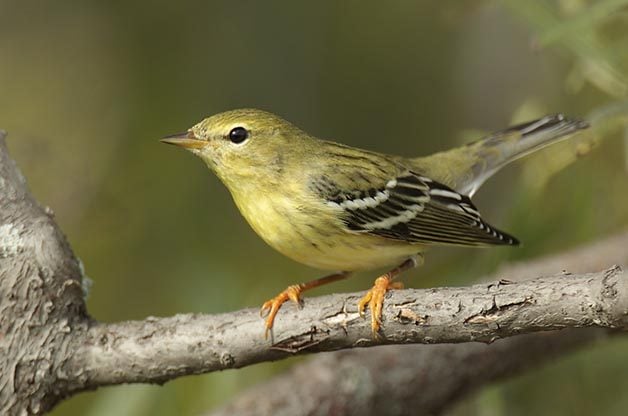
Blackpoll Warbler
Both the blackpoll warbler and bay breasted warbler are yellowish overall and have two white wingbars, so those features aren’t going to be very helpful. On the blackpoll warbler, look for very light and blurry dark streaking on the sides and across the breast. Also, if you can get a look at the legs and feet and they have any yellow on them, you have a blackpoll warbler.

To make things even more confusing, blackpoll warblers molt into completely different plumage in the fall. During the breeding season, these birds look much different—the males are black and white with a black cap.
For me, blackpoll warblers have the craziest migration pattern of any of the warblers. Here’s a fascinating fact: Blackpoll warblers fly for an impressive 80+ hours nonstop during fall migration. Their epic trip from northern Canada to South America includes nearly 2,000 miles across the open water of the Atlantic Ocean.
After breeding across the boreal forests of Canada and Alaska, the whole population migrates east towards the Atlantic Ocean. Once they reach the ocean, they will feed heavily in hopes of doubling their body weight and then take off and fly straight out over the open water heading east. They will rely on strong winds to push them south so that they can arc down to South America, at some points being closer to Africa than the American continents! Many of the birds will make landfall on the northeast coast of South America.
Their migration north in the spring will take them island hopping through the Caribbean and then through the central United States back to their breeding grounds in the north.
Yellow warbler vs goldfinch: Here’s how to tell the difference.
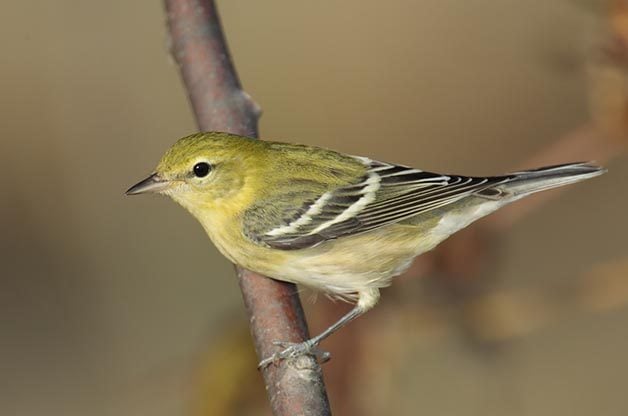
Bay Breasted Warbler
Unlike the blackpoll warbler, the bay breasted warbler doesn’t show much streaking at all. Instead, many times it will show a slightly creamy or buffy color. Some individuals will even show a hint of the bay color they are named for. Also note that this species has entirely black/gray legs and feet.
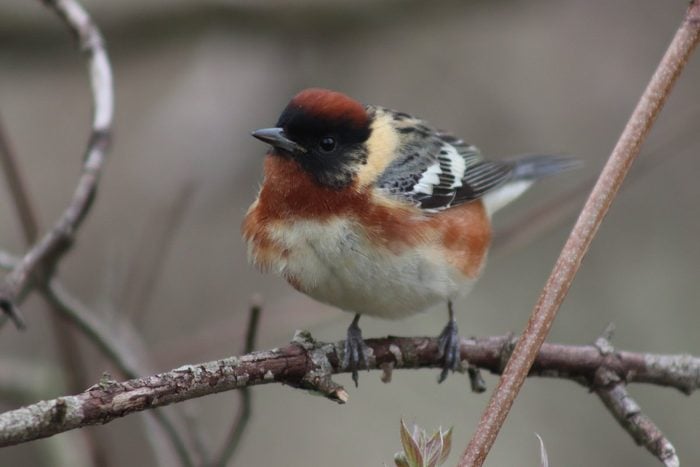
Like the blackpoll warbler, this species does a seasonal costume change. In the breeding season, these warblers are mostly gray with a chestnut colored head, throat and sides.
Next, learn all about black-throated blue (and green!) warblers.

When it comes to love and marriage, bird mating habits aren’t much different than people. Birds meet and then carry on a courtship that includes dinner dates, dancing and just hanging out together. Birds, especially males, sing, show off a lot and wear flashy adornments just to impress females. Then if the two birds like each other, they become a pair, build a nest, raise youngsters, school them and send them off to form their own families. Also like people, pairs are not always faithful and will have flings with individuals other than their own mates. If the marriage doesn’t result in raising young, the pair may “divorce”, remarry and try again. Discover the monogamous birds that mate for life.
Birds That Mate for Life
It’s fairly rare to find monogamous birds that remain together “until death do us part,” a fact not realized until pretty recently. Until the development of DNA fingerprinting techniques in the 1980s, most people thought birds faithfully mated for life, or at least for the season. Using DNA, scientists have produced some shocking discoveries. Most birds are far from monogamous.
Most birds do not mate for life, and most of those that do aren’t quite as faithful as we’d like to think. Over 92 percent of all bird species form a pair bond and stay together for at least part of the nesting cycle. Yet DNA tests of baby birds have shown that in over 75 percent of these species, some birds have mated with one or more birds other than their “social mate.”
These sweet photos show how birds flirt and attract mates.
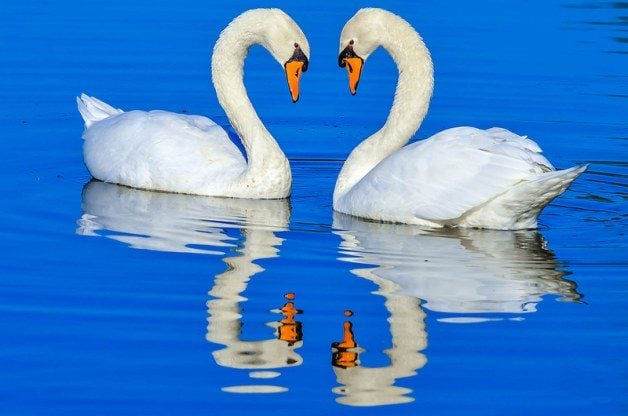
Monogamous Birds
Yet, there are a few species of birds that meet, court and form pair bonds that result in many offspring, year after year, until one of the pair dies. For nearly all swans, geese, ducks, cranes, storks and a few others, long-term monogamy is the preferred relationship. Even though these birds are quite loyal, few demonstrate the fidelity of the Bewick’s swan, a European native. At the Wildfowl Trust in Slimbridge, England, swans have been studied for more than 50 years. In all that time, the researchers haven’t found a single case of “divorce” among the thousands of Bewick’s swan pairs that have successfully raised young.
We can assume that our native tundra and trumpeter swans are much the same. Wild swans probably survive an average of 12 years, with records of them reaching 26 years of age. When one member of the pair dies, the widow or widower might eventually take a new mate, but they don’t rush into it, often taking a couple of years to find an acceptable partner. Some don’t remarry for up to 6 years after the death of a spouse.
Bald eagles mate for life, but possibly only because they can’t work out a property settlement. Eagles don’t stay together over winter, preferring separate vacations. The pair returns to the same nest each year, which can grow almost 9 feet wide. However, if one or the other doesn’t come back, the remaining bird readily accepts a new mate at the nest.
Check out 6 romantic and fascinating swan facts.
Do Finches and Hummingbirds Mate for Life?

As for our common backyard birds, like goldfinches, chickadees and robins, marriage bonds are less committed. They often last for only one breeding season or for one nesting period. Some of our most common birds, such as red-winged blackbirds, house wrens and ruby-throated hummingbirds, have communal relationships in which one male and several females all nest at the same time.
With hummingbirds, their connection is only minutes! Males have no role in building a nest, incubating eggs or raising young. Learn about the life of a female hummingbird.
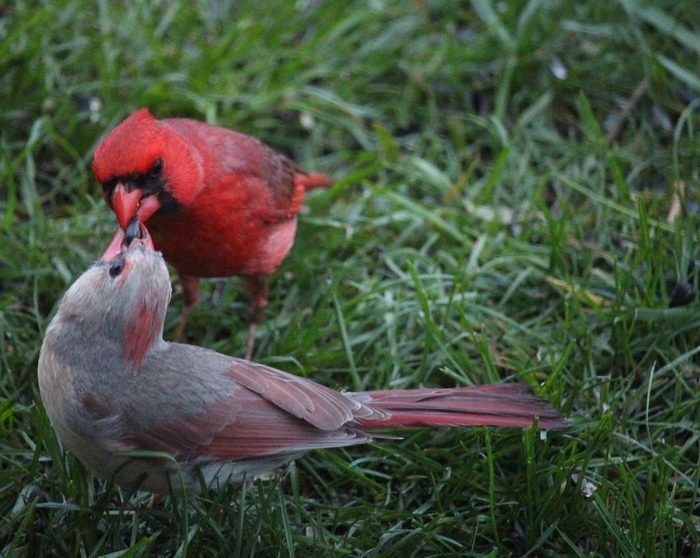
Among our favorite pairs, northern cardinals appear to have a longer-lasting marriage than most songbirds. During winter, the two are not very nice to each other, but come spring, the male’s fancy takes a new direction. Instead of chasing the female away from the bird feeder, as he did all winter, he offers her a sunflower seed and the courtship starts again. Whether they are the same male and female as last spring, we can’t be sure, but most of us would like to think so. After all, it’s nice to have the ending, “and they lived happily ever after.”
Next, check out proven tips to attract nesting birds.
Types of Grackles

Common Grackle
These medium-sized, lanky birds have glossy dark feathers. Their heads look blue or purple in the light, in contrast to their bronzed iridescent bodies. In some parts of the southeast, their bodies are more purple and/or green. Also look for long tails and bills and yellow eyes. The common grackle is larger than a red-winged blackbird but smaller than a crow (speaking of, have you ever seen a fish crow?). Common grackles can be spotted from Canada and the Great Plains to the southeastern states.
These pictures will change the way you look at black birds.
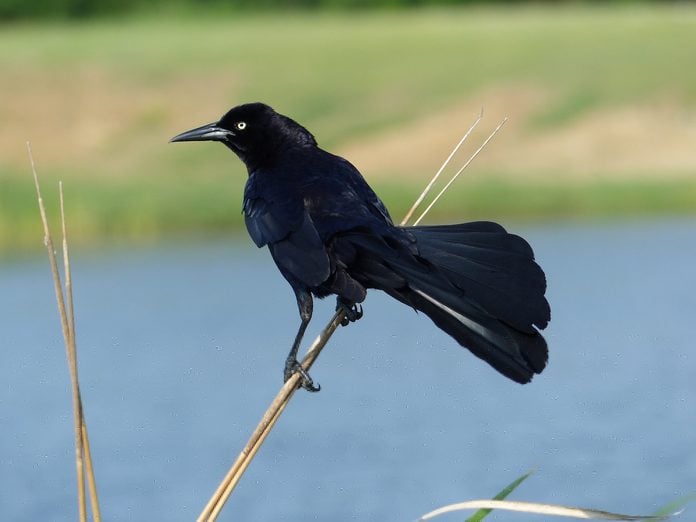
Great-Tailed Grackle
The great-tailed grackle has bold yellow eyes that seem to stand out against their dark silky-looking feathers. Like the common grackle, in the sunlight, they appear to have a blue/purplish color tone. However, their broad, fan-shaped tails set them apart. Their heads are flat, not rounded like boat-tailed grackles. These birds are common from Texas and Oklahoma to southern California.
Discover 5 types of blackbirds you should know.

Boat-Tailed Grackle
Look for these birds throughout Florida and along the eastern and Gulf coasts. Boat-tailed grackles have rounder heads than the great-tailed grackles and dark (not yellow) eyes.
Check out 20 black and white birds you might see.

Female Grackles
Females grackles are a bit smaller than males with duller plumage. The female great-tailed grackle is dark brown above and lighter brown on the chest, with a light brown eyebrow.
Learn everything you should know about European starlings.

Juvenile Grackles
According to birding experts Kenn and Kimberly Kaufman, the photo (above) shows a young male boat-tailed grackle molting into adult plumage. “The head and parts of the bird’s wing still have brown juvenile feathers, but the black adult feathers have grown in on other areas of the wing and body. The tail feathers are frayed, but after the new feathers grow in, the tail will look longer and blacker. The bird may be in an awkward adolescent phase now, but it won’t stay that way for long.”

Juvenile common grackles are brown with dark colored eyes. “In the first week of July, I heard some loud bird noises outside our home in Prescott, Wisconsin. Stepping out to see what was going on I saw this adult common grackle and two youngsters on a nearby wire having a very loud family discussion. I went for my camera hoping they’d still be there when I got back. They were, and I got this action shot (above). The young ones are obviously wanting to be fed!” says Darrell P. Delahousaye.
Psst—you need to see these pictures of super cute baby birds.
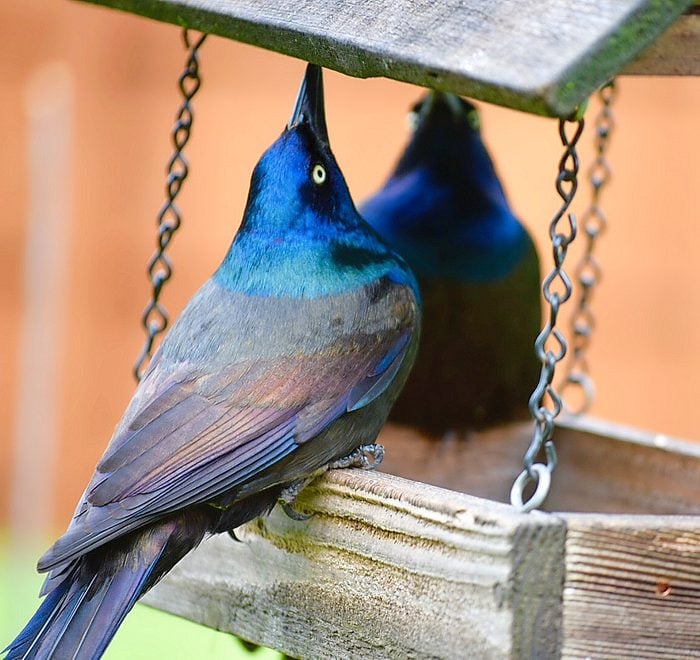
What Do Grackles Eat?
Grackles will eat many types of grain and seeds, including cracked corn and sunflower seeds, as well as peanuts. They also eagerly devour suet. In summer, these birds also eat insects, berries and small animals such as frogs and mice.
The Kaufmans advise, “If you’re dealing with a large flock of grackles, the good news is that it’s probably a migratory flock that will stay only a few days before moving on. If they linger too long, you might simply stop filling the feeders for a few days until they go.
Or switch to a different type of feeder. “A tube feeder for thistle (nyjer) seed, with very small perches, will be challenging for grackles but just fine for small finches,” the Kaufmans said.
Learn more tips to get rid of blackbirds and grackles at feeders.
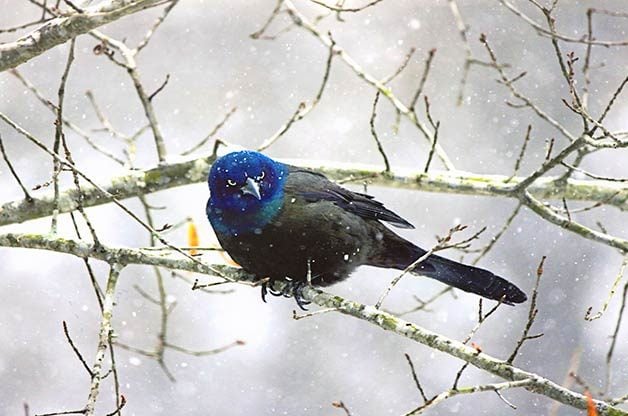
Do Grackles Migrate?
Grackles are found year-round throughout most of the United States. Birds that breed in the northern part of their range migrate short distances for winter.
Learn fascinating facts about common ravens.

Grackle Nest
Female grackles construct the nest, often choosing nest sites in conifer trees that offer dense cover. These birds may nest in large groups or colonies near water.
Discover interesting facts about red winged blackbirds.

Are Grackles Corvids?
Though they are each large dark colored birds, grackles are not related to crows. Grackles are in the Icteridae, or blackbird family, which includes orioles and cowbirds. Crows are corvids, more closely related to jays and magpies.
Raven vs crow: Here’s how to tell the difference.
Types of Blackbirds
The blackbird family (Icteridae) includes many species not called blackbirds, such as orioles, meadowlarks, bobolinks and cowbirds. Other birds, such as crows, ravens and starlings, are also primarily black colored, but are in different bird families. Here are five types of blackbirds that you might spot.
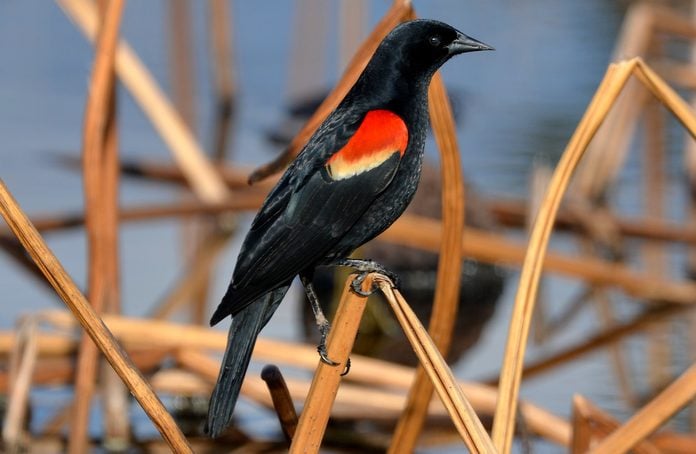
Red-Winged Blackbird
Male red-winged blackbirds, flashing their scarlet shoulder patches, are common across North America. You can find these birds in a variety of habitats. They’ll adapt to pond edges, weedy ditches or even brushy fields. Some of these birds are probably nesting in just about every county in the Lower 48 states. Their total population is estimated at 130 million to 190 million birds.
Check out the most frequently sighted bird in every state.
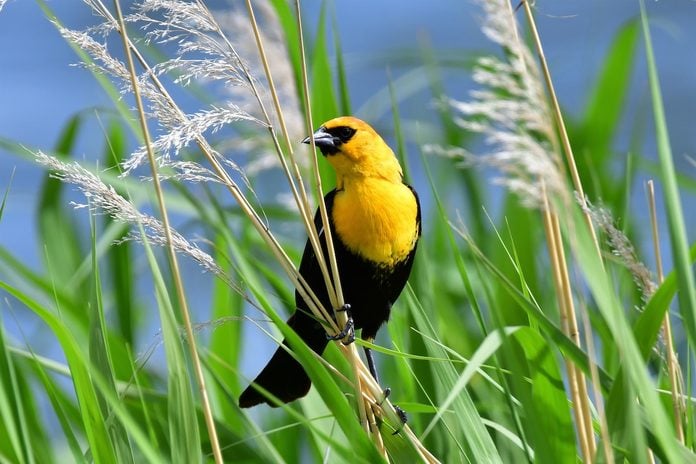
Yellow-Headed Blackbird
According to Kaufman field guide, yellow-headed blackbirds attract attention with their flashy colors and terrible attempts at singing. The song is described as “a few gurgles followed by a long, strangled buzzing noise.” On the males, a white wing patch is visible in flight. Look for these black and yellow birds in western marshes in summer.
Discover vibrant tanager bird species to know.

Rusty Blackbird
In fall, you can see the rusty brown plumage (above) that gives this bird its name. The buff colored eyebrow is another key field mark. During other seasons, male rusty blackbirds are a dull black color with yellow eyes. This uncommon (and declining) species is almost always spotted by water. Rusty blackbirds nest around far northern bogs and spend winters in southeastern swamps.
Meet the 8 types of jays you should know.
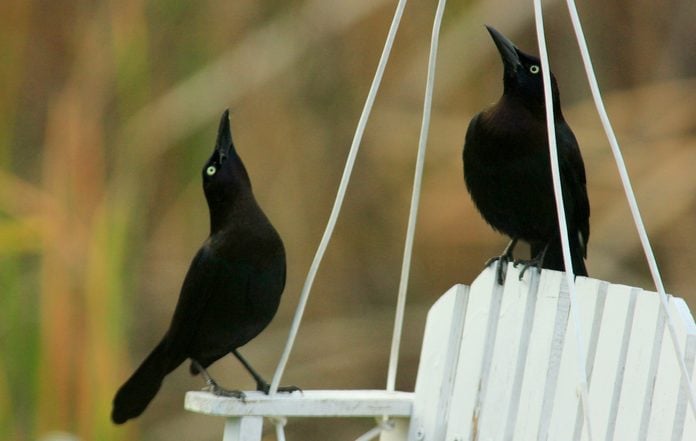
Brewer’s Blackbird
Look for these types of blackbirds in the western United States. According to the Kaufman field guide, they are ” very common in open country…near the Pacific coast, and also in cities, walking about on busy sidewalks.” Brewer’s blackbirds resemble grackles but have shorter tails. They are slightly larger than cowbirds. Males have glossy black feathers and white colored eyes.
Check out 20 black and white birds you might see.

Tricolored Blackbird
Head to California if you want to see a tricolored blackbird. It resembles the red-winged blackbird, but is rarer. Their shoulder patch is red and white, not red and yellow. They are very social birds that are frequently seen in large groups.
Next, learn about the 15 types of hummingbirds found in the United States.
